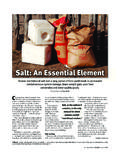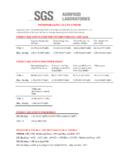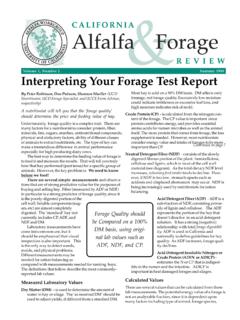Transcription of Byproducts Offer Alternatives - feedingandfeedstuffs.info
1 By Troy Smith F or the producer concerned about possible negative effects of supplementing the cow herd's forage-based industry, wheat midds contain higher levels of fiber, protein and minerals than the parent grain, but have lower amounts of Be aware that neither wheat midd pellets nor cubes will store like grain, Blasi warns. Producers often report problems diet with starchy feed ingredients such as starch and energy. Available as pellets or with extended on-farm storage, particularly corn or other grains, there are Alternatives .
2 Cubes, the fiber-friendly nature of wheat in summer heat and humidity when the Digestible fiber energy sources, such as midds means energy may be added to pellets may soften and mold. It might be wheat middlings, corn gluten feed and forage-based diets with little or no negative best to start with small quantities until the soybean hulls, are less likely to depress impact on forage digestibility. However, producer learns how to handle the forage intake or digestibility. All of these Blasi says wheat midds generally are high in product.
3 Feedstuffs originated as Byproducts of phosphorous and low in calcium, so CONTINUED ON PAGE 134. grain-processing industries, but many producers may need to adjust mineral processors now refer to them as co- supplementation accordingly. products and have become more aggressive in their marketing efforts. According to Dale Blasi, Kansas State University (K-State) Extension specialist, the drawback to some byproduct feeds is that availability may be seasonal if processing does not occur year-round.
4 Certain products may be most practical for producers in regions where the source crop is grown and processed, and transportation costs are low. It depends on the product, but if the mills only run part-time, supplies may be variable. Prices are, too. If low supply coincides with high demand, it drives up the cost, Blasi says. There are storage and handling challenges with some of them. Everything has its drawbacks, but producers shouldn't ignore these Byproducts .. Wheat midds and straw Working in Kansas and having family ties to eastern Colorado, Blasi has seen many producers use wheat midds in rations for growing cattle, but also as an economical supplement for cows.
5 Fort Collins, Colo., cattleman Mike Pay says he will save a dollar per head per day while feeding his cows pelleted wheat midds and straw instead of hay costing well over $100. per ton. After coming off grass in the fall, Pay's registered Angus herd grazes cornstalks until January. From then until spring turnout, the PHOTO BY SHAUNA ROSE HERMEL. cows are fed 17 lb. of wheat midds per day and 15-20 lb. of barley straw. If I'm feeling particularly generous, I. might give them a few pounds of alfalfa hay.
6 But probably not, Pay says, grinning. The barley straw costs $60 a ton and wheat midds cost $100. That puts the per-cow feed cost at about $ per day, instead of $ when going the usual (all hay) route.. @Corn is not the only feedstuff that can be used to supplement cows during periods of drought and reduced forages. Wheat middlings, corn gluten feed and soybean hulls are all options to supplement A byproduct of the flour-milling for digestible fiber energy sources. October 2002 ANGUSJ ournal 133.
7 Byproducts Offer Alternatives CONTINUED FROM PAGE 133. wet corn milling industry's production of Table 1: Typical composition of commonly used forages and alternative feed sources corn starch, corn syrup and corn oil. It is feed % DM1 % TDN2 % Protein available in either wet or dry forms, with the Corn .. 86 90 10 latter being easier to handle and cheaper to PHOTO BY SHAUNA ROSE HERMEL COURTESY OF BEEF MAGAZINE. Ear corn .. 87 83 9 ship. Gluten feed is frequently used in Soybean hulls .. 91 78 12 feedlot rations, because it provides similar Wheat midds.
8 90 85 19 gains and feed efficiencies as corn grain. Corn gluten feed (dry) .. 88 77 21 Depending on availability and price, it also Corn gluten feed (wet) .. 60 86 20 may be a viable alternative feed for Distillers' grain, corn (dry) .. 92 90 29 supplementing forage, without depressing Distillers' grain, corn (wet) .. 30 90 29 fiber digestibility. Wheat straw .. 90 42 4. Alfalfa hay (early bloom) .. 90 60 18 Comparing costs Prairie hay (med. quality) .. 90 50 8 When comparing costs of alternative feed Sudan hay (early).
9 89 56 9 sources, it's a good idea to make sure you're 1 comparing apples to apples. Extension DM = dry matter. 2. TDN = total digestible nutrients. beef specialist Cody Wright, South Dakota State University, recommends that producers use a delivered cost per ton of dry matter (DM) for each feed source Soy hulls lows to contract soy hulls, they're considered, then compare them for energy, Soy hulls (the outer covering of the competitive with corn. And you don't have or total digestible nutrients (TDN), and soybean) are another popular choice as an to worry about depressing forage protein.
10 Energy supplement to high-forage diets. utilization. For example, suppose the delivered cost Their highly digestible fiber content makes of corn is $70 per ton. Corn is 86% dry them comparable to corn as an energy Distillers' grain matter and 90% TDN, so to obtain the source, but they contain very little starch. In the process of making ethanol, the corn's cost per ton of TDN, make the The typical crude protein (CP) value of soy starch in corn or other grains is converted following calculations: hulls is listed as 12%, but actual protein to alcohol and removed.




